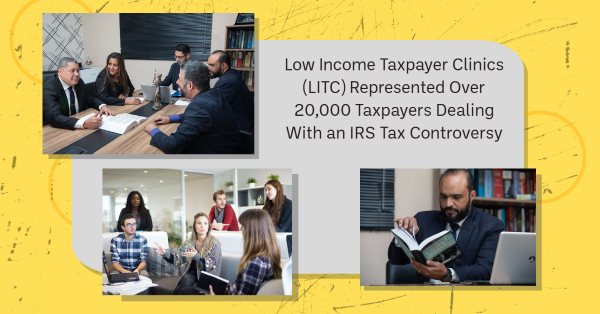Low Income Taxpayer Clinics (LITC) Represented Over 20,000 Taxpayers Dealing with an IRS Tax Controversy

The Internal Revenue Service's Low Income Taxpayer Clinic (LITC) Program office released highlights from its 2020 annual report, featuring successful taxpayer outreach to thousands of taxpayers. The report describes how LITCs provide representation, education and advocacy for taxpayers who are low income or speak English as a second language (ESL). The program also announced its 2021 LITC grant recipient list.
The LITC Program is a federal grant program administered by the Taxpayer Advocate Service, led by National Taxpayer Advocate Erin M. Collins. LITCs represent individuals whose incomes are below a certain level, generally within 250% of the federal poverty guideline, and need to resolve tax problems with the IRS, such as audits, appeals and tax collection disputes. They can represent taxpayers in court as well as within the IRS. They also can provide information about taxpayer rights and responsibilities in different languages for ESL taxpayers. LITCs provide services for free or a small fee. They receive IRS grants but work independently to assist and advocate for taxpayers.
“I applaud the Low Income Taxpayer Clinic Program for another successful year filling a crucial role in helping low-income taxpayers resolve their tax problems with the IRS,” said National Taxpayer Advocate Erin M. Collins. “The services LITCs provide are critical, and I encourage organizations to consider applying for an LITC grant to open a clinic, especially in areas currently lacking an LITC.”
Thousands of taxpayers impacted
During 2019, LITCs represented 20,259 taxpayers dealing with an IRS tax controversy. They helped taxpayers secure more than $6.8 million in tax refunds and reduced taxpayers' liabilities by more than $50 million. They also brought more than 4,100 taxpayers back into payment compliance.
Through outreach and education activities, LITCs strived to ensure individuals understood their rights as U.S. taxpayers by conducting more than 1,800 educational activities that were attended by nearly 42,000 people. More than 1,500 volunteers contributed to the success of LITCs by contributing over 52,500 hours of their time. More than 65% of the volunteers were attorneys, certified public accountants, or enrolled agents.
LITCs used a variety of approaches to successfully advocate for taxpayers. These included utilizing collection alternatives to resolve issues administratively within the IRS, litigating cases in the United States Tax Court and other federal courts, and elevating systemic issues through the Taxpayer Advocate Service's Systemic Advocacy Management System.
One success story among many
Here is one example of how an LITC assisted a taxpayer in need: A domestic violence shelter referred a recently divorced mother to an LITC for assistance with a large tax liability. The taxpayer explained that her ex-husband was a heroin addict who abused her for years. The taxpayer’s divorce decree ordered her ex-husband to pay their large tax bill to the IRS, but the taxpayer was concerned he would not pay it. She explained that her ex-husband had hidden income from her and did not provide all his income documents when she prepared their joint tax returns.
The IRS discovered the unreported income and adjusted their tax returns, resulting in a large tax liability. The LITC helped the taxpayer gather supporting documentation and prepared a Form 8857, Request for Innocent Spouse Relief. With the documentation gathered by the taxpayer, the LITC established that the tax liability resulted from the ex-husband’s unreported income and that the taxpayer experiencing domestic violence didn’t know, or have any reason to know, of the unreported income when she signed the joint tax returns.
The IRS determined it would be unfair to hold this taxpayer liable and granted her full relief.
The full report PDF contains more extraordinary stories about the representation that LITCs provide and extensive details about the LITC Program. It also details the results that LITCs achieved on behalf of their clients.
How to Locate an LITC Near You
Through the LITC Program, the IRS awards matching grants of up to $100,000 per year to qualifying organizations. IRS Publication 4134, Low Income Taxpayer Clinic List PDF, provides a list of the 2021 LITC grant recipients by geographic area, including contact information and details about the languages, in addition to English, in which each LITC offers services. Publication 4134 is available at IRS.gov.




